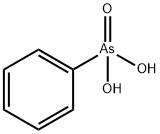
ФЕНИЛАРСОННАЯ КИСЛОТА
- английское имяPHENYLARSONIC ACID
- CAS №98-05-5
- CBNumberCB9684423
- ФормулаC6H7AsO3
- мольный вес202.04
- EINECS202-631-9
- номер MDLMFCD00002097
- файл Mol98-05-5.mol
химическое свойство
| Температура плавления | 160 °C |
| Температура кипения | 66 °C(Press: 1 Torr) |
| плотность | 1,76 g/cm3 |
| растворимость | 3.2% in water and 15.5% in ethanol. |
| пка | pK2: 8.48(+1) (22°C) |
| форма | Powder |
| цвет | white |
| Удельный вес | 1.76 |
| Растворимость в воде | 31.6g/L(28 ºC) |
| Мерк | 14,1067 |
| Справочник по базе данных CAS | 98-05-5(CAS DataBase Reference) |
| Рейтинг продуктов питания EWG | 1 |
| FDA UNII | 57F9KU116M |
| Система регистрации веществ EPA | Benzenearsonic acid (98-05-5) |
| Коды опасности | N-T | |||||||||
| Заявления о рисках | 50/53-23/25 | |||||||||
| Заявления о безопасности | 61-60-45-28A-20/21 | |||||||||
| РИДАДР | 3280 | |||||||||
| RTECS | CY3150000 | |||||||||
| TSCA | Yes | |||||||||
| Класс опасности | 6.1 | |||||||||
| Группа упаковки | III | |||||||||
| кода HS | 29310099 | |||||||||
| Банк данных об опасных веществах | 98-05-5(Hazardous Substances Data) | |||||||||
| Токсичность | LDLo orl-rat: 50 mg/kg JPETAB 93,287,48 | |||||||||
| NFPA 704: |
|
рисовальное письмо(GHS)
-
рисовальное письмо(GHS)


-
сигнальный язык
опасность
-
вредная бумага
H301:Токсично при проглатывании.
H400:Чрезвычайно токсично для водных организмов.
H410:Чрезвычайно токсично для водных организмов с долгосрочными последствиями.
H331:Токсично при вдыхании.
-
оператор предупредительных мер
P261:Избегать вдыхания пыли/ дыма/ газа/ тумана/ паров/ аэрозолей.
P304+P340:ПРИ ВДЫХАНИИ: Свежий воздух, покой.
P405:Хранить в недоступном для посторонних месте.
ФЕНИЛАРСОННАЯ КИСЛОТА химические свойства, назначение, производство
Химические свойства
white to slightly yellow crystalline powderИспользование
Arsonic acids (arsonic acid, phenylarsonic acid, p-hydroxyphenylarsonic acid, arsanilic acid) react with the tetravalent metals of group IV of the periodic system to give water-insoluble complexes of composition MA2 . The composition of the precipitates is not exactly stoichiometric, and hence the precipitates are not suitable for direct gravimetric analysis. Instead, the precipitates are transformed by ignition to the corresponding metal oxides and weighed as such. The main advantage of the application of these reagents is the possibility offered of the selective determination of zirconium(IV), hafnium(IV) and titanium(IV) in the presence of many other metals, such as zinc, manganese, nickel, cobalt, aluminium, copper, calcium, magnesium and chromium. In practice they are utilized most frequently for the determination of zirconium.In strong mineral acidic media phenylarsonic acid forms water-insoluble precipitates with zirconium and hafnium only. In highly concentrated acetic acid solution the thorium phenylarsonate complex is also precipitated, which makes possible the separation of thorium from rare earth metals.
The procedure gives satisfactory results in the presence of alkaline earth metals, iron, aluminium, manganese, cobalt, nickel, copper, zinc and bismuth.
Общее описание
Colorless solid. Used as an analytical reagent for tin.Профиль реактивности
PHENYLARSONIC ACID emits poisonous fumes of arsenic when heated to decomposition. [EPA, 1998].Угроза здоровью
PHENYLARSONIC ACID is a deadly poison. (Non-Specific -- Arsenic Compounds) Chronic exposure to arsenic compounds can cause dermatitis and digestive disorders. Renal damage may develop.Пожароопасность
PHENYLARSONIC ACID emits poisonous fumes of arsenic when heated to decomposition.Профиль безопасности
A deadly poison by ingestion andintravenous routes. When heated to decomposition it emits toxic fumes of As.Возможный контакт
This material is used as an analytical reagent for tin.Перевозки
UN3280 Organoarsenic compound, liquid, n.o.s., Hazard Class: 6.1; Labels: 6.1—Poisonous materials, Technical Name Required. Potential Inhalation Hazard (Special Provision 5).Методы очистки
Crystallise it from H2O (3mL/g) between 90o and 0o. Alternatively dissolve 600g of the acid in 500mL of boiling H2O, add 20g of Norite, filter hot, cool, filter off the crystals and dry them. On heating at ~154-160o it is converted to the anhydride. [Bullard & Dickery Org Synth Coll Vol II 494 1943, for the 4-nitro derivative see Ruddy & Starkey Org Synth Coll Vol III 665 1955, Beilstein 16 H 868, 16 I 448, 16 II 457, 16 III 1057, 16 IV 1183.]ФЕНИЛАРСОННАЯ КИСЛОТА запасные части и сырье
ФЕНИЛАРСОННАЯ КИСЛОТА поставщик
| поставщик | телефон | страна | номенклатура продукции | благоприятные условия |
|---|---|---|---|---|
| 86-13657291602 | CHINA | 22963 | 58 | |
| +86-0551-65418671 +8618949823763 |
China | 34563 | 58 | |
| +86-89586680 +86-13289823923 |
China | 8670 | 58 | |
| +86-852-30606658 | China | 43340 | 58 | |
| +1-+1(833)-552-7181 | United States | 57505 | 58 | |
| +86-0592-6210733 | China | 32343 | 55 | |
| 400-6106006 | China | 30123 | 84 | |
| 021-021-58432009 400-005-6266 |
China | 44689 | 61 | |
| 400-1166-196 18981987031 |
China | 11707 | 57 | |
| 4008-755-333 18080918076 |
China | 9718 | 55 |